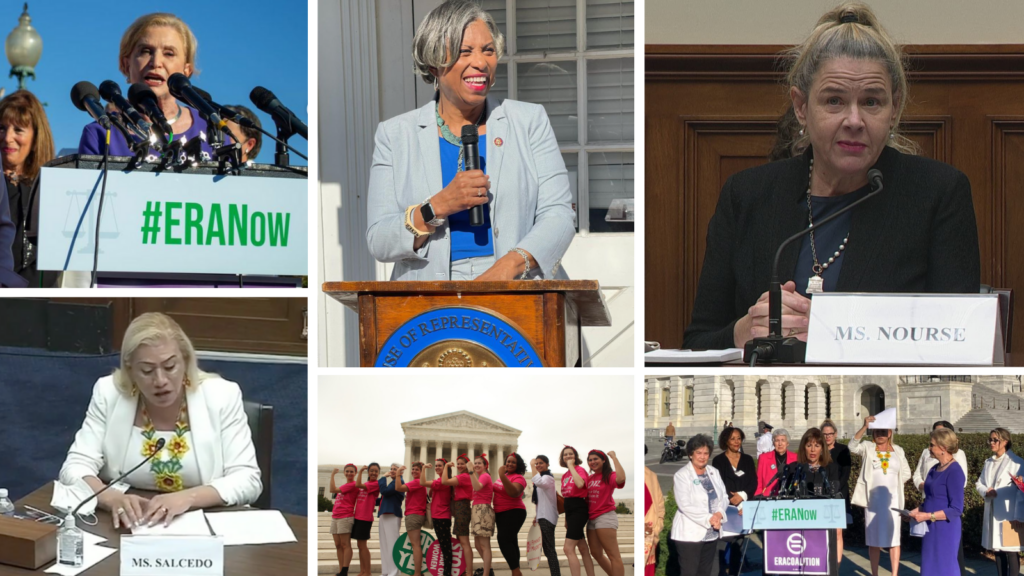
On Thursday, October 21, advocates testified before the House Oversight & Reform Committee on the Equal Rights Amendment (ERA), including president of Feminist Majority, Ellie Smeal; actor and activist Alyssa Milano; Virginia state Senator Jennifer McClellan; president and CEO of the ERA Coalition, Carol Jenkins; founder of the TransLatin@ Coalition, Bamby Salcedo; and constitutional law scholar Victoria Nourse.
During the hearing, members of Congress and ERA advocates outlined the need for the ERA and detailed how it has met the amending process requirements, as outlined in Article V of the Constitution, and therefore should be immediately added as the 28th Amendment. They testified on the dramatic impacts the amendment would have on women, people of color and the trans community, and how the proposed amendment could help shore up gaps in abortion access.
As a collective, the testimony made a legal, constitutional and ethical case for one demand: ERA now.
Members of Congress and ERA advocates set the context for the historic hearing.
Rep. and Oversight Committee Chair Carolyn Maloney (D-N.Y.):
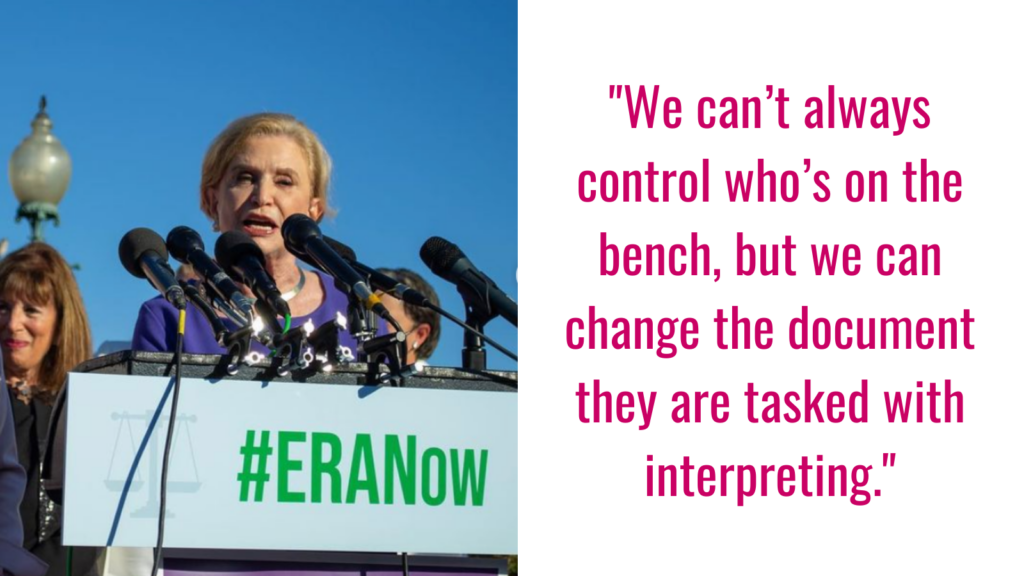
[A]s the first woman to chair the Committee on Oversight, I’m particularly proud to convene this hearing on what I believe is one of the most important things we can do to ensure equality for women in our country, finally putting women and the Equal Rights Amendment in the Constitution.
Discrimination against women is a persistent problem, yet our country’s fundamental document does not guarantee equality. … The Equal Rights Amendment was written more than 100 years ago by the legendary suffragist Alice Paul. ….
After decades of effort, the ERA finally passed the House in October 1971, 50 years ago this month, in a strong bipartisan vote. It passed the Senate overwhelmingly the following year.
Thirty-eight state legislatures have voted to ratify the ERA, meeting the constitutional requirement, but the ERA still does not appear in the Constitution, and this has to change. Federal law directs archivists of the U.S. to certify and publish amendments that have met the requirements laid out in Article V of the Constitution. This is purely ministerial duty, which should be done automatically—but under President Trump, the Department of Justice issued an opinion advising the archivists not to certify the ERA.
Today, I’m releasing a letter from preeminent legal scholars stating that this Trump era legal opinion is legally erroneous and should be withdrawn.
After 100 years, women cannot wait any longer for full constitutional equality. … Today, equal rights can be too easily rolled back depending on the ideological leanings of Supreme Court justices, but constitutional amendments are permanent. We can’t always control who’s on the bench, but we can change the document they are tasked with interpreting, so that it better reflects the equality that all Americans deserve.
Rep. Jackie Speier (D-Calif.):
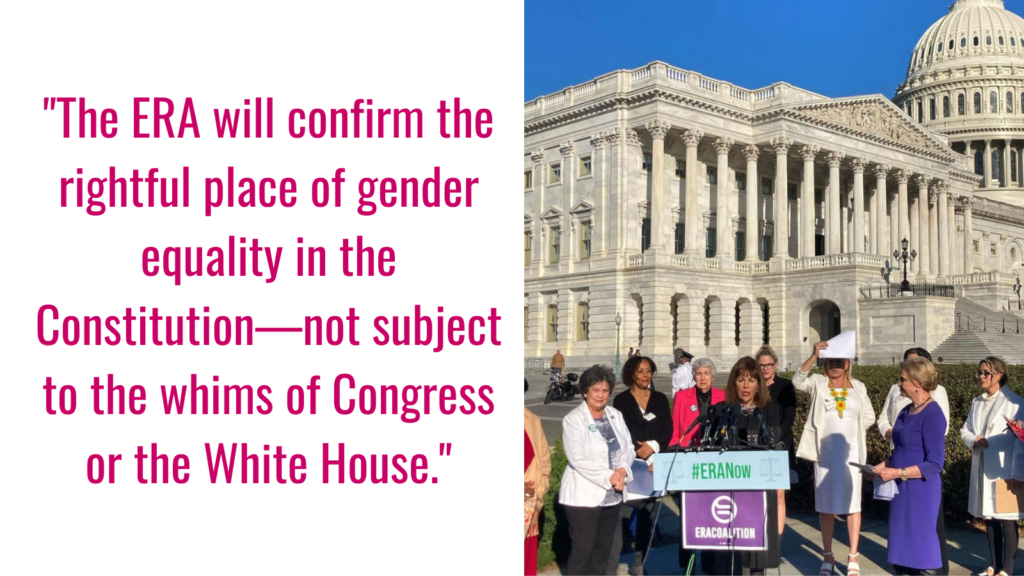
We’re here today to acknowledge a sad truth: Our country’s founding was based exclusively on excluding women in the Constitution. It was intentional. We were deprived our basic rights to vote, prevented from being hired for most jobs and for owning property.
To this day, we are paid less for our work, violated with impunity and discriminated against simply for being who we are.
The ERA will create stronger legal recourse against sex discrimination and empower Congress to better enforce and enact laws protecting women and confirm the rightful place of gender equality in the Constitution—not subject to the whims of Congress or the White House.
Mark my words, we will get this done. We must get this done. Our daughters and granddaughters demand it.
Rep. Brenda Lawrence (D-Mich.):
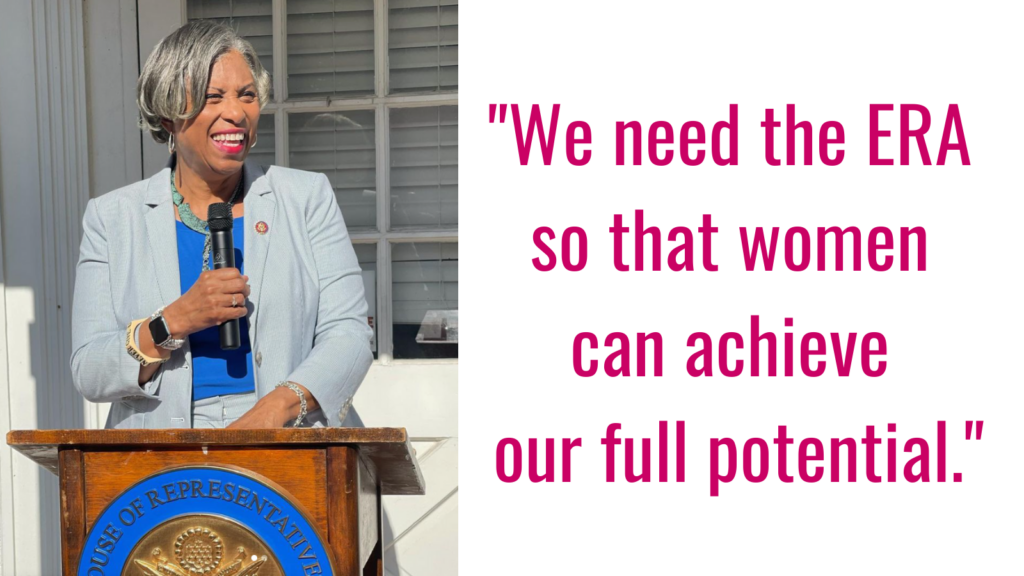
The urgent need for the Equal Rights Amendment is very clear. We have been treated as second-class citizens. At one time in our history and had to abide by laws that gave us no voice or representation. And for those who still question the need for the ERA take a look at gender wage gap. Take a look at the loss of reproductive freedoms.
At minimum, can we as a country state that we are equal? We need the ERA so that women can achieve our full potential. We need to ERA to ensure that the rights of women and girls will not be rolled back by the political whims of the day but instead be preserved as the basic rights guaranteed by the United States Constitution.
Virginia state Sen. Jennifer McClellan:
I’m here as a daughter, granddaughter and great granddaughter of educators, domestic workers, community leaders and civil rights activists who struggled for equality in the segregated South. I’m here as a mother who does not want to leave the fight for equality to my children Jackson and Samantha. I am here as a legislator who helped lead Virginia to become the 38th and final state necessary to ratify the Equal Rights Amendment last year.
The history of my family and my commonwealth is one of facing inequities and working to create a better future for the next generation. Virginia’s ratification was led by multigenerational black women … With the ratifications of the Equal Rights Amendment by Nevada, Illinois and Virginia, the states have now done our part.
It is now time for the national archivist to do his and certify the ratifications of these three states and publish the amendment. It is time. It is past time for the U.S. Constitution to join over 100 Constitutions across the world in having gender equality in the Constitution, including every Constitution adopted since World War II.
Alyssa Milano:
While I will speak briefly about the importance of the ERA, this hearing is not a debate on that amendment. That debate is over. We won.
The states have directed Congress to amend the Constitution and now it is the duty of Congress and the administration to get out of the way.
If there is one word which defines the American identity it is freedom … but how can we be a free people when our governing document does not prohibit discrimination against more than half of the population? The answer of course is that we cannot. … As long as the Constitution allows gender-based discrimination, the United States can never achieve the greatness to which it aspires.
There are many current gender driven injustices in our country, but the Constitution is not simply about the present. The Constitution is about what we bring far into the future. It exists to protect us from the what ifs. The ERA will outlive every one of us. It is a permanent protection of our most basic rights.
Carol Jenkins:
This fight for the ERA has lasted a century. …
What the Equal Rights Amendment will do and what we desperately need is fundamental constitutional underpinning of the rights of women and girls. … We need to come to grips with the fact that the Constitution does not fully support girls and women. …
Some people have said, ‘You know, it’s just a symbol.’ I say, ‘Yeah, like the flag. All right. Give it to us.’ We need that symbol as well as the legal rights that go with it. We need young girls to feel that they belong here. We need women to not be engaged in this constant quest for equality and for rights. …
[As] the grandmother of two biracial children who have two mothers, I want this country to reflect their lives. I don’t want them to be ashamed of who they are. I want their ability to be recognized in the Constitution of the United States to be true and I believe the only way that can happen is by enacting the ERA.
Ellie Smeal:
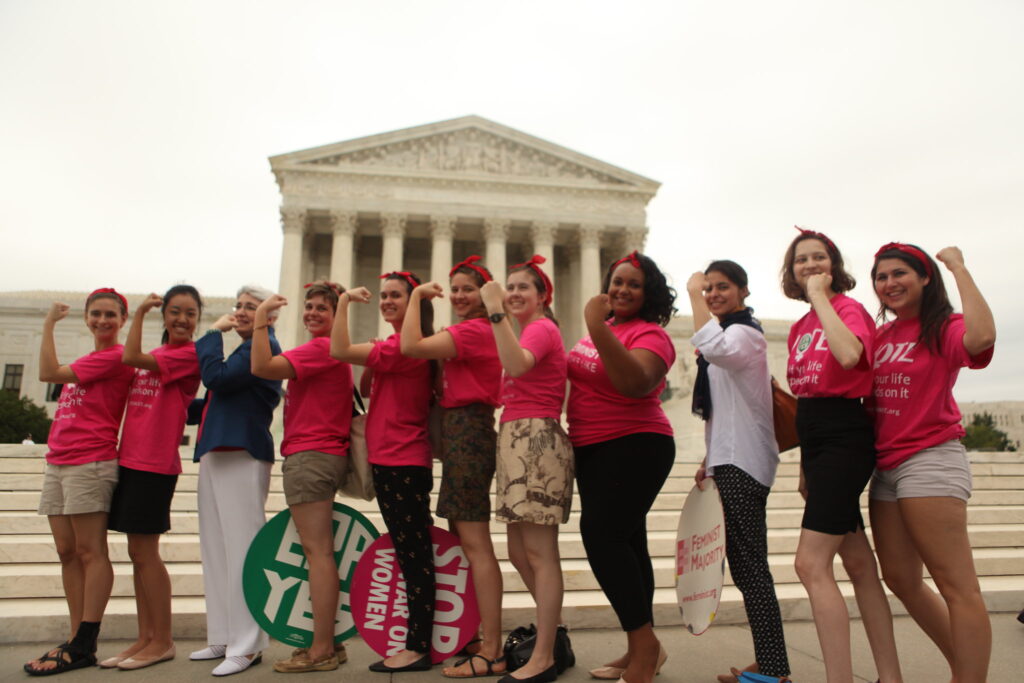
I have worked for the passage of the Equal Rights Amendment for over 50 years. The arguments that you have heard against it, I have had to listen to for over 50 years. I know what side I’ve been on because while we’ve been fighting for gender equality to be placed in the Constitution, we’ve also been fighting day in and day out to empower women and girls and to win gender equality for all.
Who opposed the ERA? The biggest opposition to the ERA came from the Chambers of Commerce, National Association of Manufacturers and the insurance companies—they were big lobbyists against us. One of the insurance companies even put an ad out saying: “Our case for sex discrimination.”
At that time, health insurance, life insurance, auto insurance, annuities, pension plans … all discriminated on the basis of sex … If you looked at health insurance, it was very discriminatory. [It] frequently did not cover pregnancy and usually charged women between 150 and 200 percent more for the same coverage [as that for men]. In other words, they were taken advantage of.
I could go on but basically, there was a lot of vested interests in keeping women in a certain position. We talk about essential workers all the time, but they were forced to work at minimum wage because, in fact, there weren’t that many opportunities for women.
Bamby Salcedo:
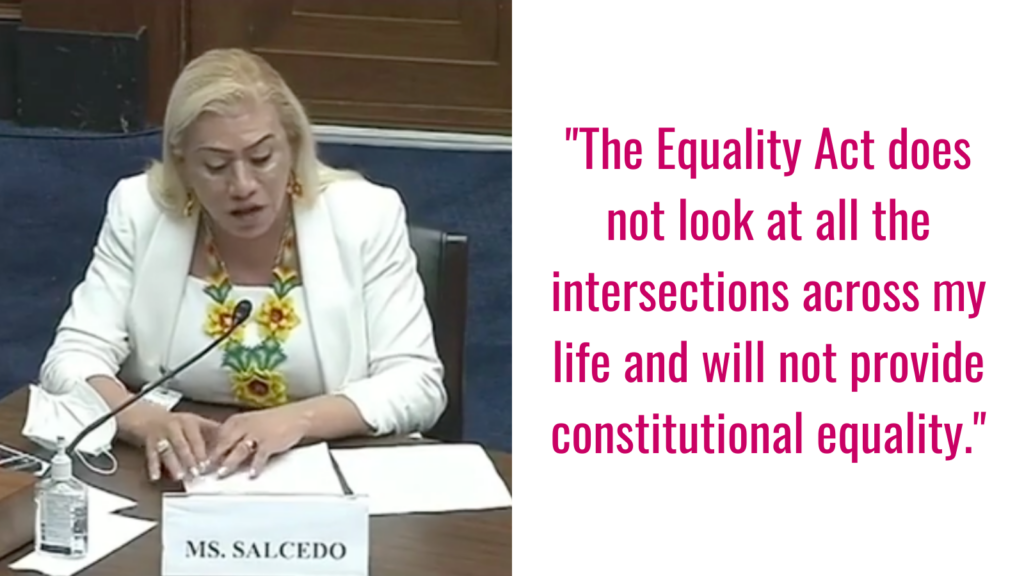
I am very privileged trans Latino woman. … My experience is that of a person who has had … to survive many horrific experiences simply for being who I am. [T]here were no laws or protections against discrimination to protect people like myself.
My hope is that you understand the opportunity that we have in this moment in time. That you understand that the Equal Rights Amendment is what our nation needs right now to heal the intergenerational wounds generated against a most marginalized.
I know that you’re probably going to say: What about the Equality Act? The truth is that the Equality Act does not look at all the intersections across my life and will not provide constitutional equality.
I hope you open your hearts and your minds and you do the humane thing to do to ensure that all peoples—not only those who are like me—have the rights that we deserve, that we get to be acknowledged as the human beings that we are, that we’re given some dignity and that we honor the work of many people who have tried for more than five decades to ratify the Equal Rights Amendment.
Victoria Nourse:
We now have a [Supreme] Court of nine unelected men and women, six of whom idolize Justice Scalia [who said] …certainly the constitution does not require discrimination on the basis of sex. The only issue is whether it prohibits it. Nobody ever thought that’s what [the 14th Amendment] meant.
The six justices who have publicly aligned themselves with him have a judicial philosophy … that is known as textualism or originalism. I write about this. I study it. What that means is if it’s not in the Constitution, it doesn’t exist. This is a new theory. So, even if there are precedents on the books … there’s no guarantee that this Court will not overturn them.
Other than the 19th Amendment, which gave women the right to vote, women are not recognized in the Constitution’s text. Without the Equal Rights Amendment as a constitutional insurance policy, all of the things that women take for granted could simply go away with a vote of five men on the Supreme Court.
Unequal protection is not a fantasy. It is a reality every day.
The ERA will have a dramatic impact on women and people of color.
Rep. Cori Bush (D-Mo.):
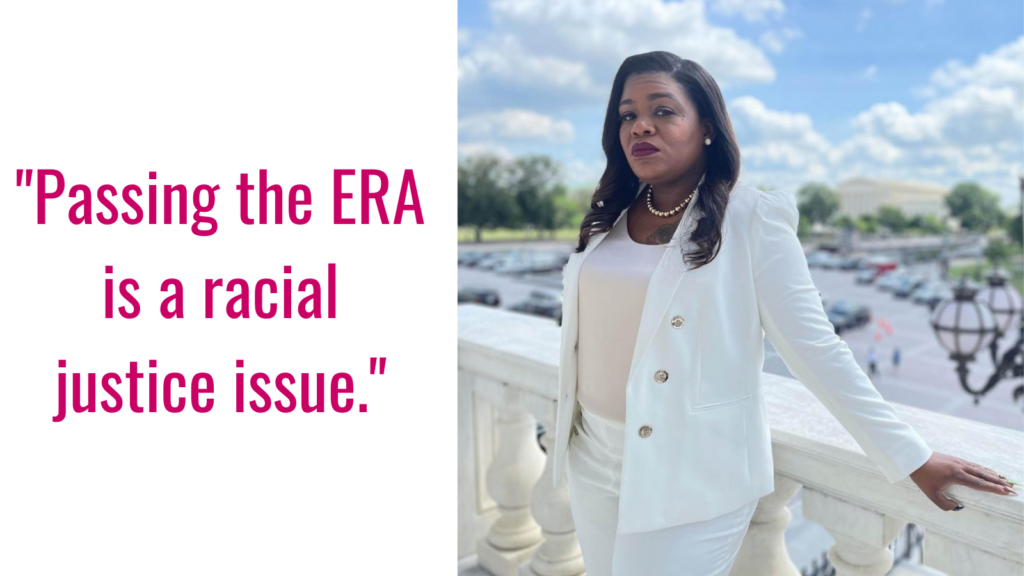
Equal rights for everyone are still not codified in this country and it shows. Ratifying the ERA after over a century of struggle will help advance social, economic and racial justice. It will improve the lived experiences for Black women who are disproportionately affected by inequality and inequity in this country.
It is not surprising that the slave holders, all white men, who wrote the Constitution, did not write in equal rights across genders, and it is not surprising that their disregard for gender equity has disproportionately harmed Black women, Brown women, indigenous women and trans women. Notice I said “and, and, and, and, and.” Passing the ERA is a racial justice issue.
The ERA will have a positive impact on all genders.
Rep. Debbie Wasserman Schultz (D-Fla.):
I want to drill down and explore how the ERA could effect a specific legal claim in my home state of Florida. On the first day of Pride month, the governor of Florida signed a horrendous law banning trans girls from playing on sports teams with other girls. …
Professor Nourse, how might the ERA influence outcomes when judges review laws like this trans phobic sports ban given the decision in Bostock v. Clayton County?
Nourse:
The Supreme Court decided a case called Bostock recently in which the question was whether Title VII covered trans gender and sexual orientation discrimination—and the court said, as a matter of statutory interpretation, that they were covered in Bostock. But that’s a statute, it’s not the Constitution.
And so, the court has recognized that the word sex for statutory interpretation includes these categories, but it’s not clear that that would actually operate in the same way constitutionally.
So, as far as a state law that discriminated against transgender folks, the Equal Rights Amendment would allow challenges to that law based on the interpretation of the word “sex.”
The Supreme Court may decide the right to abortion is not currently protected by the Constitution. The ERA can shore up gaps in abortion access.
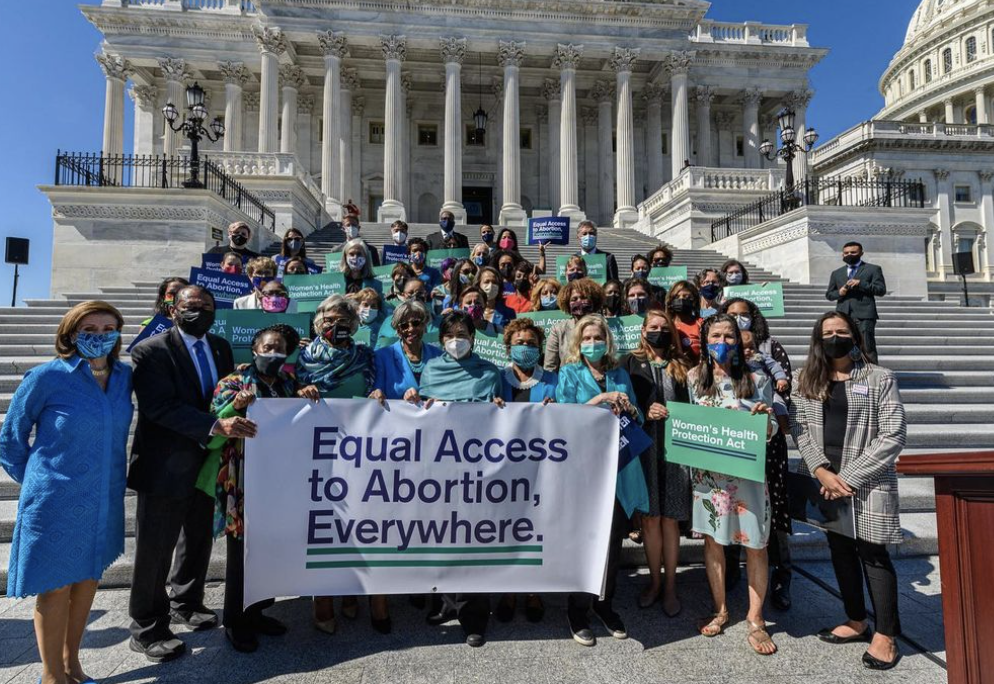
Rep. Ayanna Pressley (D-Mass.):
Senator McClellan, can you explain the role abortion care plays in advancing health and economic equity for historically marginalized communities and how you’ve seen that play off of your constituents in Virginia specifically?
McClellan:
The Supreme Court has long recognized that reproductive freedom is essential to one’s equality. As the court said in Planned Parenthood v. Casey, the ability of women to participate equally in the economic and social life of the nation has been facilitated by their ability to control their reproductive lives.
Abortion is healthcare and the ERA is about gender equality in access to healthcare, and the workplace, and in school, and every aspect of federal and state law in policy. And in particular, Black women have been disproportionately discriminated on the basis of pregnancy—and the ERA would also help with that.
And as we have seen states threaten access to abortion, the ERA can help.
Pressley:
Professor Nourse, at a moment when abortion bans like Texas’s S.B.8 are threatening pregnant people’s right to healthcare, why are the constitutional protections of the ERA particularly important?
Nourse:
They’re particularly important because the current court has shown itself to be rather sympathetic to the point that the right to privacy is not in the Constitution, and therefore, without actual text, without a text of the ERA, it may well be that the court reverses Roe v Wade.
The ERA has met all necessary requirements to be added to the Constitution—regardless of the arbitrary time limit in the preamble.
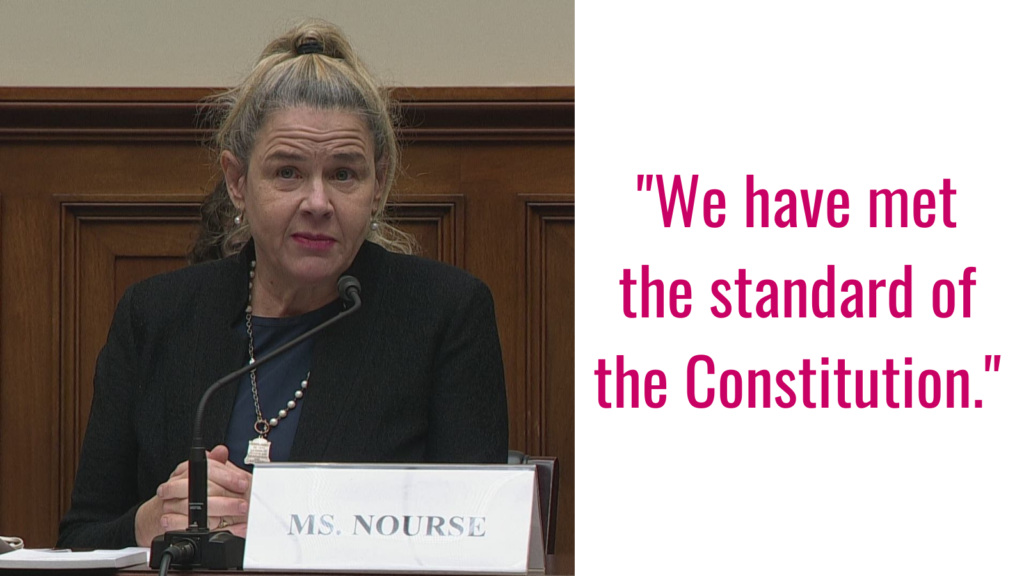
Rep. Gerry Connolly (D-Va.):
Professor Nourse, Article V of the Constitution reads, and I quote: “The Congress, whenever two-thirds of both houses shall deem it necessary, shall propose amendments to the Constitution, which shall be valid to all intents and purposes as part of the Constitution when ratified by the legislatures of three fourths of the several states.” Is that correct?
Nourse:
That’s correct and thank you for reading the text.
Connolly:
Has the ERA in fact met that standard?
Nourse:
We have met the standard of the Constitution.
Connolly:
So, we had statutory language putting a time limit in the preamble to the language of the amendment itself. Is that correct?
Nourse:
That’s correct. It’s in the preamble.
Connolly:
Senator McClellan, can you enlighten us, when you and your colleagues looked at the ERA, given what Professor Nourse just said, how did you look at … the prefatory language in the statute, versus the actual text of the amendment in front of you, and why did you decide you could proceed?
McClellan:
We looked at the prefatory language as not the amendment itself, and nothing in the Constitution discusses time frames or time limits or even if they would be valid. And so, we looked at the text of the Constitution and what it told us to do was ratify the amendment. That’s what we did.
Connolly:
And therefore, there was no impediment from your point of view. I don’t mean to put words in your mouth. I’m asking: There was no impediment to you actually acting in ratifying the amendment?
McClellan:
That’s right. The states are told by Article V to ratify. There’s nothing in the amendment process, in the Constitution about deadlines or rescissions and we did what we were authorized to do under the Constitution.
Connolly:
I contend based on this testimony that the ERA is now an amendment to the Constitution, duly ratified by the 38th state, the Commonwealth of Virginia.
The Trump-era memo from the Office of Legal Counsel, which concluded the archivist could not publish the ERA because the time limit had passed, is not legally binding.
Rep. Jamie Raskin (D-Md.):
[O]n January sixth last year, the DOJ Office of Legal Counsel (OLC) issued an opinion in response to a request from the National Archives and Records Administration on the ERA, and … concluded the archivist could not publish the ERA because the time limit had passed. The archivist has stated that this OLC opinion prevents him from certifying and publishing the ERA.
Professor Nourse, I want to ask you about the validity of this 2020 OLC opinion from the last administration and the role of the executive branch in the constitutional amending process.
First of all, as a general matter, are OLC opinions binding precedent—like a decision of a federal district court or the U.S. Supreme Court?
Nourse:
No. They are not binding.
Raskin:
And are there situations in which OLC opinions are actually withdrawn, or modified, or reversed, and if so, what are the circumstances under which a prior OLC opinion might be changed or withdrawn?
Nourse:
Well, yes, there’s a very famous instance where an OLC opinion appeared to endorse torture and the administration withdrew it. In this case, the OLC opinion actually contradicts prior OLC opinions, the Trump opinion contradicts some prior opinions from earlier.
Raskin:
So, there’s nothing unusual at all about changing or reversing a flawed OLC opinion when one administration looks back and finds legally unsound reasoning underlying a prior one, especially when the prior one itself was a reversal of a prior opinion that came to that administration?
Nourse:
That’s correct.
Raskin:
So, let’s come back to the substance then. Professor Nourse, in your opinion, is the 2020 OLC opinion legally sound?
Nourse:
No. Because it is inconsistent with the Supreme Court’s decision in Coleman v. Miller. It purports to bind Congress to the deadline in a way that’s inconsistent with the Supreme Court’s opinion, [which concluded the amendment process] … is a political question that the Court cannot opine on and that is my position. I don’t think that the Court would take this.
Up next:





